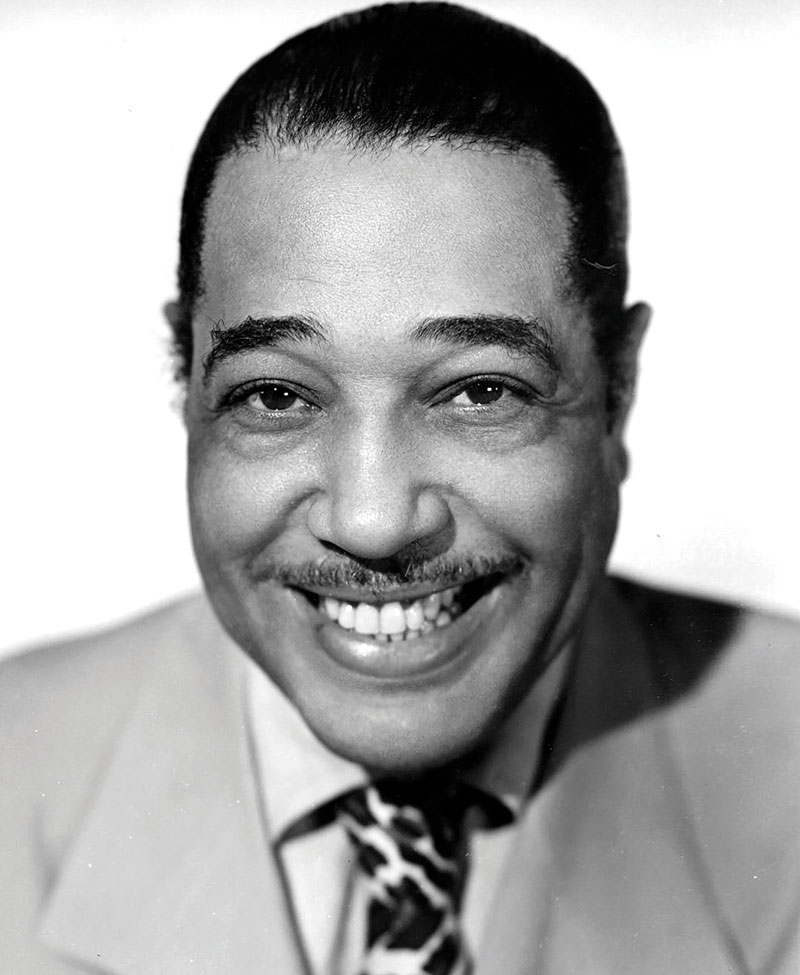Edward K. (“Duke”) Ellington

- Born: April 29, 1899, Washington, D.C.
- Died: May 24, 1974, New York, New York
Night Creature
- Composed: 1956, on commission from Don Gillis and the Symphony of the Air
- Premiere: 1956, Don Gillis and the Symphony of the Air, Carnegie Hall, New York
- Instrumentation: 2 flutes (incl. piccolo), oboe (incl. English horn), 2 clarinets (incl. bass clarinet), 2 alto saxophones, 2 tenor saxophones, baritone saxophone, bassoon, 2 horns, 4 trumpets, 3 trombones, tuba, timpani, bongo drums, maracas, suspended cymbals, drum set, jazz bass, harp, piano, strings
- CSO notable performances: First/Most Recent Performance: April 2021, Louis Langrée conducting.
- Duration: approx. 17 minutes
Duke Ellington’s influence on American music is far-reaching. Not only did he blur the lines that existed between popular and classical music, but Ellington also challenged the cultural hierarchy that devalued Black music. Throughout his nearly five-decade career, Ellington used his music as the platform to promote racial pride, historize the Black experience in America, and advocate for social change and racial understanding. He also had a whimsical side that underscored some of his more experimental works like the opera Queenie Pie and the tone poem Night Creature.
In the 1950s, when jazz shifted to an aesthetic centered on smaller ensembles, Ellington continued to chart of course of experimentation that positioned the jazz orchestra as the vehicle for an idiom of American concert music. Along with pianist/arranger Mary Lou Williams, he was instrumental in elevating the jazz suite and tone poem as vehicles for advancing the modern orchestral jazz aesthetic that appeared in the 1940s. Most of Ellington’s compositions in this idiom were written primarily for standard jazz orchestra (big band) instrumentation. However, in 1955, he extended his compositional voice to include the symphony orchestra. Commissioned by Don Gillis for the Symphony of the Air, Night Creature premiered in Carnegie Hall the same year, but was not recorded by Ellington until 1963.
The composition is a three-movement nocturnal fairytale that explores the activities of the insects, monsters and creatures that rule the night. Each movement portrays a different scenario and also different melodic and thematic material.
The first movement, “Blind Bug” tells the story of “a blind bug who comes out every night to find that because he is king of the night creatures, he must dance. The reason he is king, of course, is that being blind, he lives in night all day, and when night really comes, he sees as well as anyone else, but with the difference that he is accustomed to not seeing. So, he puts out his antennae and goes into his dance, and if his antennae warn him of danger, he pauses, turns in another direction, and continues bugging the jitterbugs.” This movement is pure Ellingtonia and a reminder that he never conformed to conventions that defined the sound of the commercialized jazz idiom that grew in popularity during the 1930s and 1940s. The riffs and rhythms are funky, smooth, and sophisticated providing the perfect palette for this nocturnal dance.
The second movement, “Stalking Monster” is “concerned with that imaginary monster we all fear we shall have to meet some midnight, but when we meet him, I’m sure we shall find that he too does the boogie-woogie.” This movement takes on the identity of a concerto grosso with groupings of instruments scripting small ritornelli that build on the “stalking” motive introduced by the piano and drums at the beginning. This blues-tinged ostinato is developed through the introduction of different riffs that alternate with solos played by violin, trumpet and alto sax . Emblems of Ellington’s style, like growling trumpets, and trombones, complex rhythmic and melodic interplay between sections of instruments, are present throughout.
The underpinning of the clave rhythm of Afro-Cuban music as well as the inclusion of bongos, maracas and claves in the third movement, invokes comparisons with Juan Tizol’s “Caravan,” which became a staple in Ellington’s performance repertory. “Dazzling Creature” portrays the culminating event of nocturnal activities—the entrance of the Queen of the Night.
“Night creatures, unlike stars, do not come out at night—they come on, each thinking that before the night is out, he or she will be the star. They are the restless cool whose exotic or erotic animations, no matter how cool, beg for recognition, mainly from the queen, that dazzling woman who reigns over all night creatures. She is the theme of the third movement. sitting there on her high place and singing, ‘I want to be acknowledged’ (in D major), or ‘Who but me shall be desired?’ (in A-flat), or ‘Who has the taste for my choreography?’ (in A minor). After having made each of her subjects feel that Her Majesty sings only for him or her, who is individually the coolest or craziest, her high-toned highness rises and snaps her fingers. As they stomp off the handclapping, everybody scrambles to be in place, wailing and winging into the most overindulged form of up-and-outness.”
In 1974 Alvin Ailey choreographed a series of dances to this music. Night Creature is one of many Ellington compositions that remains a staple in the famed dance company’s repertory.
—Dr. Tammy L. Kernodle